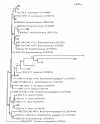Symbiotic functioning and bradyrhizobial biodiversity of cowpea (Vigna unguiculata L. Walp.) in Africa
- PMID: 20331875
- PMCID: PMC2858033
- DOI: 10.1186/1471-2180-10-89
Symbiotic functioning and bradyrhizobial biodiversity of cowpea (Vigna unguiculata L. Walp.) in Africa
Abstract
Background: Cowpea is the most important food grain legume in Sub-Saharan Africa. However, no study has so far assessed rhizobial biodiversity and/or nodule functioning in relation to strain IGS types at the continent level. In this study, 9 cowpea genotypes were planted in field experiments in Botswana, South Africa and Ghana with the aim of i) trapping indigenous cowpea root-nodule bacteria (cowpea "rhizobia") in the 3 countries for isolation, molecular characterisation using PCR-RFLP analysis, and sequencing of the 16S - 23S rDNA IGS gene, ii) quantifying N-fixed in the cowpea genotypes using the 15N natural abundance technique, and iii) relating the levels of nodule functioning (i.e. N-fixed) to the IGS types found inside nodules.
Results: Field measurements of N2 fixation revealed significant differences in plant growth, delta15N values, %Ndfa and amounts of N-fixed between and among the 9 cowpea genotypes in Ghana and South Africa. Following DNA analysis of 270 nodules from the 9 genotypes, 18 strain IGS types were found. Relating nodule function to the 18 IGS types revealed significant differences in IGS type N2-fixing efficiencies. Sequencing the 16S - 23S rDNA gene also revealed 4 clusters, with cluster 2 forming a distinct group that may be a new Bradyrhizobium species. Taken together, our data indicated greater biodiversity of cowpea bradyrhizobia in South Africa relative to Botswana and Ghana.
Conclusions: We have shown that cowpea is strongly dependant on N2 fixation for its N nutrition in both South Africa and Ghana. Strain IGS type symbiotic efficiency was assessed for the first time in this study, and a positive correlation was discernible where there was sole nodule occupancy. The differences in IGS type diversity and symbiotic efficiency probably accounts for the genotype x environment interaction that makes it difficult to select superior genotypes for use across Africa. The root-nodule bacteria nodulating cowpea in this study all belonged to the genus Bradyrhizobium. Some strains from Southern Africa were phylogenetically very distinct, suggesting a new Bradyrhizobium species.
Figures



References
-
- Belane AK, Dakora FD. Measurement of N2 fixation in 30 cowpea (Vigna unguiculata L. Walp.) genotypes under field conditions in Ghana using 15N natural abundance technique. Symbiosis. 2009;48:47–57. doi: 10.1007/BF03179984. - DOI
-
- Mpepereki S, Wollum AG, Makonese F. Diversity in symbiotic specificity of cowpea rhizobia indigenous to Zimbabwean soil. Plant Soil. 1996;186:167–171. doi: 10.1007/BF00035071. - DOI
-
- Pule-Meulenberg F, Dakora FD. Assessing the symbiotic dependency of grain and tree legumes in N2 fixation for their N nutrition in five agro-ecological zones of Botswana. Symbiosis. 2009;48:68–77. doi: 10.1007/BF03179986. - DOI
-
- Naab JB, Chimphango SMB, Dakora FD. N2 fixation in cowpea plants grown in farmers' fields in the Upper West Region of Ghana, measured using 15N natural abundance. Symbiosis. 2009;48:37–46. doi: 10.1007/BF03179983. - DOI
-
- Makoi JHJR, Chimphango SMB, Dakora FD. Effect of legume plant density and mixed culture on symbiotic N2 fixation in five cowpea (Vigna unguiculata L. Walp.) genotypes in South Africa. Symbiosis. 2009;48:57–67. doi: 10.1007/BF03179985. - DOI
Publication types
MeSH terms
Substances
LinkOut - more resources
Full Text Sources

